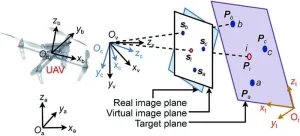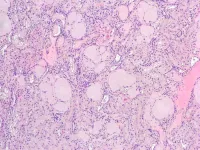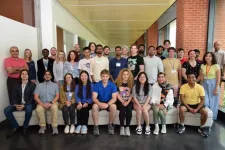(Press-News.org)
The summertime barbecue – an American tradition synonymous with celebrating freedom – may be tainted by a decidedly unfree market. A new Stanford study reveals how meat and dairy industry lobbying has influenced government regulations and funding to stifle competition from alternative meat products with smaller climate and environmental impacts. The analysis, published Aug. 18 in One Earth, compares innovations and policies related to plant-based meat alternatives and lab-grown meat in the U.S. and European Union. Its findings could help ensure legislation, such as the $428 billion U.S. Farm Bill set to expire Sept. 30, levels the food industry playing field.
(WATCH VIDEO: https://www.youtube.com/watch?v=kVDhQC17ecQ)
“The lack of policies focused on reducing our reliance on animal-derived products and the lack of sufficient support to alternative technologies to make them competitive are symptomatic of a system still resisting fundamental changes,” said study lead author Simona Vallone, an Earth system science research associate in the Stanford Doerr School of Sustainability at the time of the research.
A growing problem
Livestock production is the agriculture sector’s largest emitter of the potent greenhouse gas methane, due to emissions from ruminants such as cattle, sheep, and goats. It’s also the main direct cause of tropical deforestation, due to pasture expansion and feed crop production. Numerous studies have demonstrated that dietary changes hold great potential to reduce humanity’s ecological footprint, especially a reduction in red meat consumption. At the same time, Western-style meat-heavy diets are becoming more popular around the world.
The researchers reviewed major agricultural policies from 2014 to 2020 that supported either the animal food product system or alternative technologies, and compared government spending on both systems. They also looked at related lobbying trends.
They found that governments consistently devoted most of their agricultural funding to livestock and feed production systems, avoided highlighting food production sustainability dimensions in nutrition guidelines, and attempted to introduce regulatory hurdles, such as narrow labeling standards, to the commercialization of meat alternatives. Major U.S. meat and dairy companies actively lobbied against environmental issues and regulations to tip the scales in their favor.
In the U.S., about 800 times more public funding and 190 times more lobbying money goes to animal-source food products than alternatives. In the EU, about 1,200 times more public funding and three times more lobbying money goes to animal-source food products. In both regions, nearly all plant-based meat patents were published by a small number of private companies or individuals, with just one U.S. company, Impossible Foods, owning half of the patents.
Among the anecdotes cited by the study:
EU cattle producers were highly dependent on direct subsidy payments, which constituted at least 50% of their income during the study period. Some of these payments incentivized farmers to maintain herd size, keep pasture in production, or increase overall output.
In 2017, following a European Court of Justice ruling, dairy terms such as milk and cheese could no longer be used to market most alternative milk and dairy products. Similarly, a proposed amendment to the U.S. Federal Food, Drug, and Cosmetic Act would prohibit the sale of alternative meats unless the product label included the word “imitation” and other clarifying statements indicating the non-animal origin.
Restoring competition
This past June, the U.S. Department of Agriculture approved the sale of lab-grown chicken, the first such authorization to cultivated meat producers in the country. The Stanford study points to recent policy developments as similar glimmers of hope for a shift to more sustainable diets. In the U.S., the Inflation Reduction Act passed last year includes investments in technical and financial assistance to support farmers and ranchers implementing practices to reduce greenhouse emissions or sequester carbon. In the EU, a policy proposal set for debate this fall aims at accelerating a sustainable transition of the food system to support climate mitigation solutions, and reduce biodiversity loss and environmental impacts.
To ensure a fair marketplace for alternative meat products, policymakers should craft legislation that ensures meat’s price reflects its environmental costs, increases research on alternative meat and dairy products, and informs consumers on alternatives to meat via dietary guidelines, according to the researchers.
“It’s clear that powerful vested interests have exerted political influence to maintain the animal-farming system status quo,” said study senior author Eric Lambin, the George and Setsuko Ishiyama Provostial Professor at Stanford and senior fellow at the Stanford Woods Institute for the Environment. “A significant policy shift is required to reduce the food system impact on climate, land use, and biodiversity.”
Pat Brown, the founder and CEO of Impossible Foods, and professor emeritus of biochemistry at Stanford, was not involved in the study.
-30-
END
About The Study: The findings of this study that included 612 women suggest that adherence to preconception healthy dietary patterns before infertility treatment may be associated with a lower likelihood of pregnancy loss.
Authors: Jorge E. Chavarro, M.D., Sc.D., of the Harvard T. H. Chan School of Public Health in Boston, is the corresponding author.
To access the embargoed study: Visit our For The Media website at this link https://media.jamanetwork.com/
(doi:10.1001/jamanetworkopen.2023.29982)
Editor’s Note: Please see the article for additional information, including ...
About The Study: In a racially and ethnically diverse cohort of 34,000 adolescents, those from neighborhoods with extreme concentrations of racial and economic disadvantage were more likely to screen positive for depressive symptoms and suicidality at well-teen visits compared to their counterparts from the most racially and economically privileged neighborhoods.
Authors: Julia Acker, M.S., of the University of California, Berkeley, is the corresponding author.
To access the embargoed study: Visit our For The Media website at this link https://media.jamanetwork.com/
(doi:10.1001/jamanetworkopen.2023.29825)
Editor’s ...
About The Study: Telemedicine was rapidly adopted in skilled nursing facilities (SNFs) in early 2020 but subsequently stabilized at a low use rate that was nonetheless higher than before 2020 in this study of more than 4.4 million residents at 15,000 SNFs. Higher telemedicine use in SNFs was associated with improved access to psychiatry visits in SNFs.
Authors: Michael L. Barnett, M.D., M.S., of the Harvard T. H. Chan School of Public Health in Boston, is the corresponding author.
To access the embargoed study: Visit our For The Media website at this link https://media.jamanetwork.com/
(doi:10.1001/jamanetworkopen.2023.29895)
Editor’s ...
An estimated 1 in 4 older Americans with dementia or mild cognitive impairment lives alone and is at risk of practices like unsafe driving, wandering outside the home, mixing up medications and failing to attend medical appointments.
In a study publishing in JAMA Network Open on Aug. 18, 2023, researchers led by UC San Francisco concluded that the United States health system is poorly equipped to serve patients living solo with cognitive decline, a group whose numbers are predicted to swell as the population ages.
For these patients, living alone ...
A study published in Engineering introduces a novel image-based visual servoing (IBVS) method for unmanned aerial vehicles (UAVs) to track dynamic targets in GPS-denied environments. Titled "Dynamic Target Tracking of Unmanned Aerial Vehicles Under Unpredictable Disturbances," the research article presents a comprehensive approach that addresses the challenges of estimating target velocities, image depth estimation, and tracking stability in the presence of external disturbances.
The proposed method utilizes a constructed virtual camera to derive simplified and decoupled image dynamics for underactuated UAVs. By considering ...
The Jovian system has greatly attracted the interest of human exploration because of the important scientific value. However, Jupiter and its 4 Galilean moons form a unique and complex multi-body dynamical environment that greatly challenges trajectory design and optimization. Moreover, the extremely strong radiation environment of Jupiter and the low available fuel of spacecraft further increase the difficulty of trajectory design. In order to satisfy the requirements of diverse missions of the Jovian system exploration, develop new mission concepts, and obtain higher merit with lower cost, a variety of theories and methodologies of ...
A research group led by Dr. Tomoaki Murakami from the Tokyo University of Agriculture and Technology has revealed that fibrinogen Aα-chain amyloidosis, a previously unreported disease in animals other than humans, is highly prevalent in Japanese squirrels (Sciurus lis). In this study, they compared the pathology with that of humans, and suggested the importance of Japanese squirrels in the comparative pathological analysis of fibrinogen Aα-chain amyloidosis.
The researchers published their results on August 8th in the Journal of Pathology.
Amyloidosis is a disease group in which amyloid, generated by misfolding ...
A new study highlights the potential of artificial DNA structures that, when fitted with antibodies, instruct the immune system to specifically target cancerous cells.
Immunotherapy is viewed as an exceptionally promising weapon in the fight against cancer. In essence, the aim is to activate the body’s immune system in such a way that it identifies and destroys malignant cells. However, the destruction must be as effective and specific as possible, to avoid damaging healthy cells. A team of researchers from LMU, the Technical University of Munich (TUM) and Helmholtz Munich have now published a new study in Nature Nanotechnology in which they present ...
AUBURN, AL – In July, as many enjoyed the hot weather at Alabama's gulf coast beaches, in the Leach Science Center, Auburn University's Department of Physics hosted an engaging scientific event. For the first time since 2016, the southern USA was home to the “Hands-On Workshop on Computational Biophysics” with Auburn University, for the first time, as its esteemed host.
Under the guidance of Prof. Rafael Bernardi from Auburn University's Department of Physics and Prof. Emad Tajkhorshid of the Beckman Institute at the University of Illinois at Urbana-Champaign, the workshop showcased expertise from ...
Non-alcoholic fatty liver disease (NAFLD) is a common condition that affects up to 30% of adults in the general population. It is characterized by the accumulation of fat in the liver. It is often associated with other conditions, such as obesity, type 2 diabetes, and metabolic syndrome. The new definition of metabolic dysfunction-associated fatty liver disease (MAFLD) was proposed in 2020. MAFLD is diagnosed based on hepatic steatosis (fatty liver) and at least one of three metabolic risk abnormalities: overweight/obesity, type 2 diabetes, or evidence of metabolic dysregulation.
A recent meta-analysis led by Ming-Hua Zheng from the First Affiliated Hospital ...



